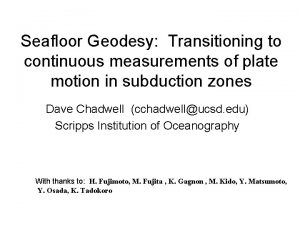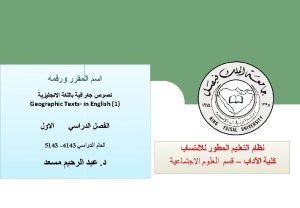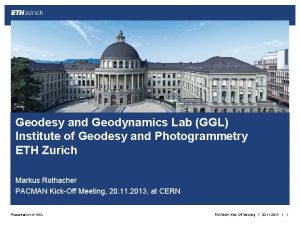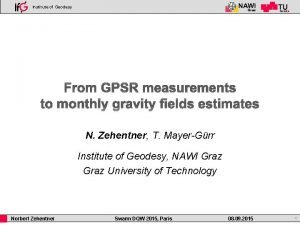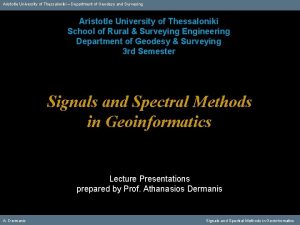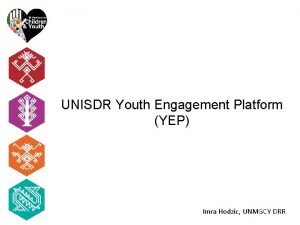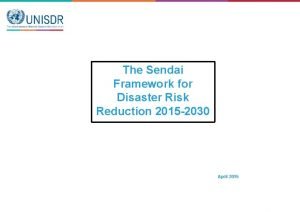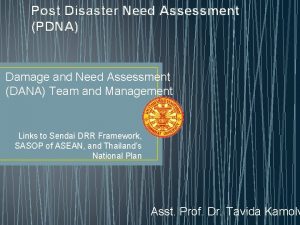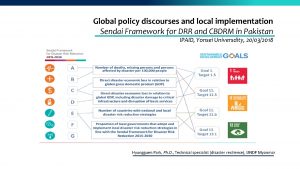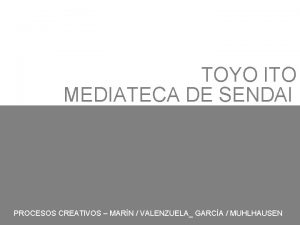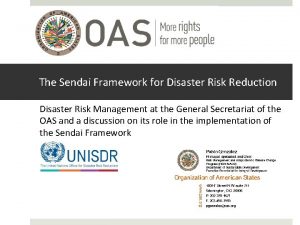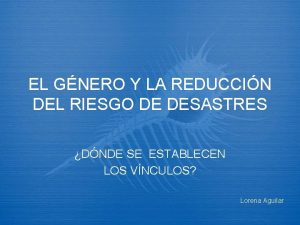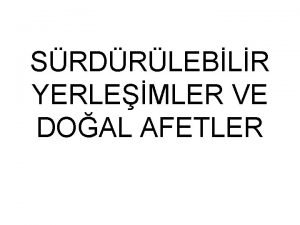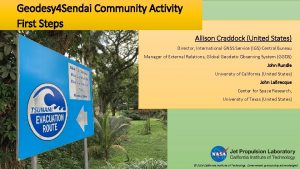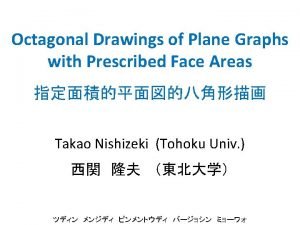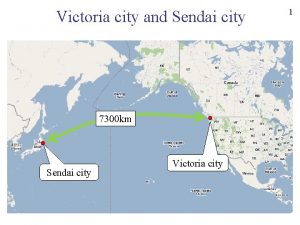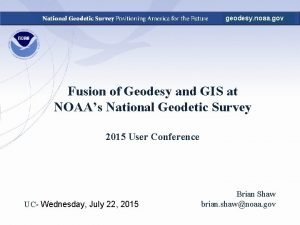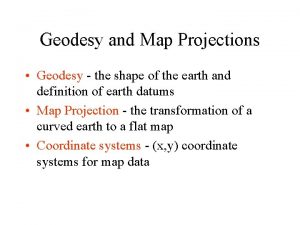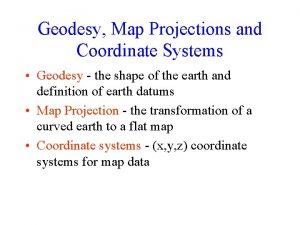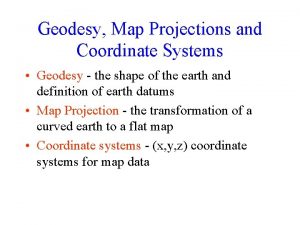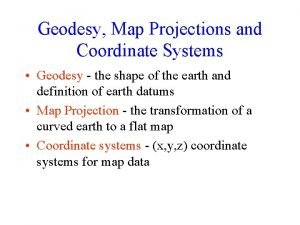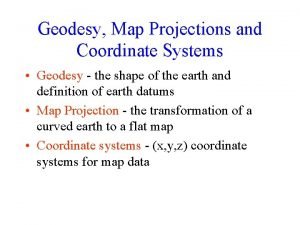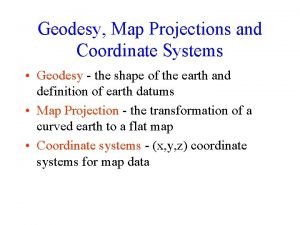Geodesy 4 Sendai Community Activity First Steps Allison














- Slides: 14

Geodesy 4 Sendai Community Activity First Steps Allison Craddock (United States) Director, International GNSS Service (IGS) Central Bureau Manager of External Relations, Global Geodetic Observing System (GGOS) John Rundle University of California (United States) John La. Brecque Center for Space Research, University of Texas (United States) © 2019 California Institute of Technology. Government sponsorship acknowledged

How does Geodesy contribute to United Nations Initiatives and other Earth Observation Multilateral Organizations? International Union of Geodesy and Geophysics (IUGG)* International Association of Geodesy (IAG)* Global Geodetic Observing System (GGOS) United Nations Committee of Experts on Global Geospatial Information Management (UN-GGIM) Subcommittee on Geodesy (SCo. G) Promoting development of an accurate, sustainable, and accessible Global Geodetic Reference Frame (GGRF) to support science and society. United Nations Office for Outer Space Affairs (UNOOSA) International Committee on GNSS (ICG) Ensuring the best satellite based positioning, navigation and timing for peaceful uses for everybody, anywhere, any time.

International Association of Geodesy (IAG) Global Geodetic Observing System (GGOS) • Vision: • Advancing our understanding of the dynamic earth system by quantifying our planet’s changes in space and time. • Mission: Programme Board Participating Organization • To provide the observations needed to monitor, map, and understand changes in the Earth’s shape, rotation, and mass distribution • To provide the global geodetic frame of reference that is the fundamental backbone for measuring and consistently interpreting key global change processes and for many other scientific and societal applications • To benefit science and society by providing the foundation upon which advances in Earth and planetary system science and applications are built http: //www. ggos. org

Supporting Sendai Coordinating Earth Observations for Disasters E: Substantially increase the number of countries with national and local disaster risk reduction strategies by 2020; GEO supports implementation of Sendai Framework targets E, F and G through engagement with UNISDR. F: Substantially enhance international cooperation to developing countries through adequate and sustainable support to complement their national actions for implementation of the present framework by 2030; G: Substantially increase the availability of and access to multi-hazard early warning systems and disaster risk information and assessments to people by 2030.


Connecting Geodesy with United Nations Initiatives : GNSS Enhanced Tsunami Early Warning Systems Geodetic observations have a clear role in helping to reduce the risk of disasters, as well as contribute to disaster preparedness with better mitigation and response. GGOS-Geohazards Working Group contributed content for the 2019 UN Global Assessment Report on Disaster Risk Reduction (GAR 19) Download GTEWS report: http: //bit. ly/gtews 2018

2017 Sendai Workshop Recommendations 1. The GGOS/IUGG, Association of Pacific Rim Universities (APRU) and the UN-GGIM are encouraged coordinate efforts to develop a GNSS Shield Consortium for the Indo-Pacific. 2. The GNSS Shield Consortium should work to encourage software, data exchange, and continued improvement of network design and performance. 3. Strengthen broadband communication to underserved regions of the GNSS Shield. 4. Work with national organizations including those mandated for natural hazards mitigation to develop agreements for [openly sharing] GNSS receivers within the GNSS Shield. 5. Design an optimal GNSS Shield network for both crustal displacement and high resolution TEC monitoring. 6. Understand the operational requirements of existing tsunami warning systems and determine the steps required to interface with existing tsunami warning systems.


GGOS Contributing Paper to the GAR is available for viewing and download

How do we support GNSS Enhanced Tsunami Early Warning Systems and other Geodetic Contributions to Disaster Risk Reduction + Resilience? Geodesy for the Sendai Framework Community Activity • Supporting geodetic development and capacity building for disaster risk reduction and resilience • Identifies existing resources and stakeholder communities, and makes connections • Identifies geodetic elements of targets and indicators of the Sendai Framework for Disaster Risk Reduction • Provides opportunity for other GEO efforts to interact with geodesy community • Integration with UN Sustainable Development Goals and UN-GGIM World Bank Integrated Geospatial Information Framework … and more…

Geodesy for the Sendai Framework Community Activity Key Objectives • Ministerial-level political support and funding for GNSS-enhanced tsunami early warning systems in the Circum-Pacific Belt (Pacific Ring of Fire) and Caribbean basin. • Ministerial-level political support and funding for geodetic capacity building for disaster risk reduction and resilience.

GTEWS/geodesy 4 sendai Workshop 2020 • Next GTEWS workshop, organized in conjunction with GEO Community Activity “geodesy 4 sendai” is in development, and scheduled to take place June 1 -5, 2020 in Sendai. • Organized to complement relevant sessions at Jp. GU-AGU 2020 (to be held one week before the workshop in Chiba, Japan) • Followed by APRU-IRIDe. S Multi-Hazards Summer School (held one week before and after the GTEWS Workshop at Tohoku University)

geodesy 4 sendai Next Steps • What does the Geodesy community need from this GEO Community Activity? • What does the Disaster Risk Reduction + Resilience community need from geodesy? • How can geodesists better engage with the broader Earth observation and disasters community? • What resources already exist, and how can we better identify and discover them? • Where are the gaps in our resources, communications, and capacities?

jpl. nasa. gov Allison Craddock craddock@jpl. nasa. gov
 Geodesy and geomatics engineering
Geodesy and geomatics engineering Seabed geodesy
Seabed geodesy Branches of geodesy
Branches of geodesy Institute of geodesy and photogrammetry
Institute of geodesy and photogrammetry Space geodesy facility
Space geodesy facility Geodesy
Geodesy Geodesy
Geodesy Yep 10
Yep 10 Sendai framework guiding principles
Sendai framework guiding principles Priority of sendai framework
Priority of sendai framework Priority of sendai framework
Priority of sendai framework Toyo ito mediateca de sendai
Toyo ito mediateca de sendai Sendai framework philippines
Sendai framework philippines Diferencia entre el marco de hyogo y sendai
Diferencia entre el marco de hyogo y sendai Yokohama stratejisi
Yokohama stratejisi

